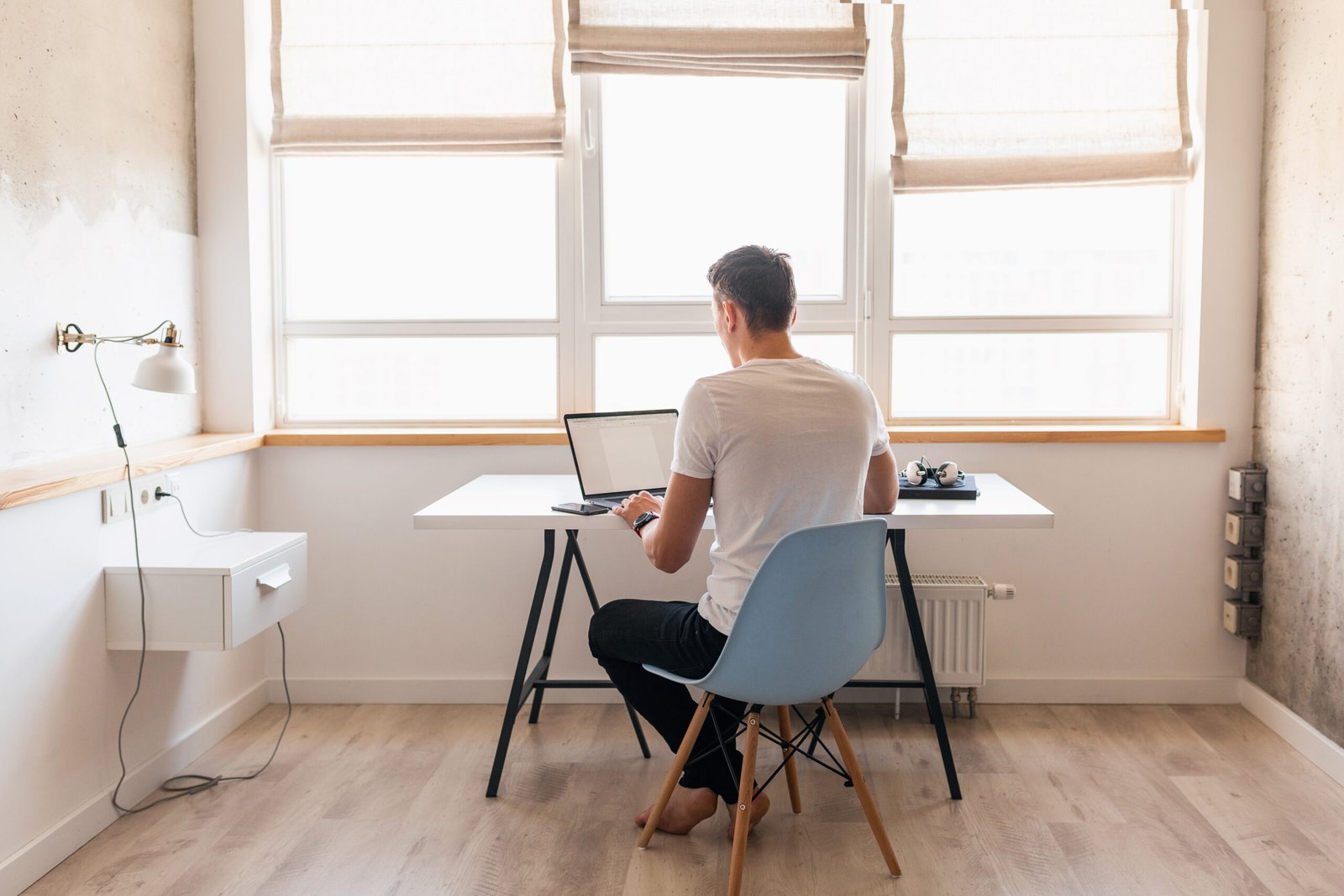Creating a peaceful and productive environment in your home office can be challenging, especially when outside noise disrupts your focus. Whether it’s the sound of traffic, kids playing, or other household distractions, background noise can make it difficult to concentrate. You’re likely wondering, how to soundproof a home office. The good news is that you don’t need a major renovation to soundproof your home office and create a peaceful environment. In this guide, we’ll discuss five easy ways to soundproof your home office without tearing down walls or making permanent changes.
SEE MORE: How to Create Private Spaces in an Open-Concept Home
1. Install Soundproof Curtains or Blinds
Installing soundproof blinds or curtains can be one of your smoothest and less expensive options to reduce the noise level. Adding thick noise-canceling curtains that are meant to absorb sound and block external noises.
Why Soundproof Curtains Work
Soundproof curtains are made of thick and dense materials that absorb sound waves, thus minimizing the echo as well as blocking noise outside. They are particularly useful if your home office has large windows that allow a lot of outside noise to seep in. The thick material absorbs sound waves before they reach your workspace so that you have a more silent space to work within.
Types of Soundproof Curtains
Thermal Curtains — For blocking out noise and insulating your room, ensuring a consistent temperature.
Acoustic Panels: Some curtains include built-in acoustic panels to provide even more noise-cancelling properties.
Installation Tips
Soundproofing curtains are quick to install, you just have to put them up as normal window dressing. For the best effect, make sure your curtains have a proper length (from ceiling to floor) and width so that they completely cover the window’s frame.
2. Rug or Carpet for Noise Reduction
The sound of your keyboard or phone calls will bounce off hardwoods and tile floors, giving the room an echoey hum that makes it seem louder than it is. An easy way you can do this is by using a fluffy rug or carpet as an added layer to absorb noise, making the space quieter.
Not Just Claimed, Sound Absorption
Solid surfaces reflect sound waves instead of absorbing them, which results in echoes and makes noise seem even louder. For example, soft surfaces like rugs absorb sound waves so that they are unable to reflect around the room soo but dwindling down your office noise.
Different Methods of Soundproofing Using Rugs and Carpets
- Shag Rugs: These rugs typically have longer, thicker fibers that will absorb more sound than thinner ones.
- Carpet Tiles: For flexibility, you can go with carpet tiles. It can be fitted in a place where more importance needs to be given to noise reduction.
- Underlay: Using a soundproof underlay beneath your rug or carpet can improve its noise-dampening ability.
Placement Tips
If your room has a rug, the better you can place it in front of or under chairs or desks. A thick carpet can help dampen a room below your home office and reduce the noise coming from above;
3. Weatherstrip Doors and Windows
If your doors and windows are not properly sealed it can have a big impact, even the tiniest gap will let sound in to disturb you while working. Weatherstripping can help block out squeaks and creaks by sealing these gaps.
Weatherstripping Works for a Reason
In any room, doors, and windows are the weakest elements of soundproofing. Since sound waves travel through the air, a small space is sufficient for noise to escape. Weatherstripping is simply a type of tape that seals gaps— areas through which sound can enter your realm.
Types of Weatherstripping
- Foam Weatherstripping – These are the simplest and most cost-effective, they will compress to give you a great seal around your doors/windows.
- Rubber Strips — A good option, because they are tough and help provide a better barrier to sound/air.
- Door Sweeps: Fix a door sweep to the bottom of your room entrance and close that gap between the floor and the sound source which is always so noisiest.
Installation Tips
Weatherstripping is a simple application. Weatherstripping is an absolute necessity Weathered doors and windows let in more than just outside air: They also drive up your heating bill. Cut the gaps around your doors or windows, then cut weather stripping to size, and apply it at all contact points between frames and sashes of both hinged openings but open shelves inside cabinets often matter too Check the door or window to make sure it opens and closes properly once you are finished installing.
4. Shelves with Books or Panels
You could always look for some stylish bookshelves to both fill the void and reduce ambient noise, or set acoustic panels on your walls. They both reduce echo and keep sound inside or out for a quieter, more professional office.
Why Bookshelves Work
Shelves packed with books make great soundproof walls. Books and the paper in them have sound-absorbing qualities while bookshelves can prevent noise from travelling through walls. A perfect solution for if your noisy room shares a wall with an office.
Benefits of Acoustic Panels
So in practical terms, that means acoustic panels to help absorb the sound waves and cut down on echo. This is not your typical aerosol spray foam; it comes in a variety of designs and colors, which can help accent the room acoustically.
Installation Tips
Place bookshelves against loud walls (like those facing a busy street or noisy room). Use acoustic panels: For the best use of absorbents, place them on walls directly next to or opposite noisy parts.
5. Rearrange your Furniture to Create a Barrier that will Help Block out Noise.
Especially when rearranging your office furniture can solve some of the noise problems. Large, heavy furniture can be useful in acting as a sound barrier to absorb some (hopefully most) of the noise coming into your home from unwanted sounds nearby.
How Furniture Affects Sound
Grander and bulkier items of furniture, such as bookshelves, desks, or cabinets defend sound waves like a block. If possible, place this type of thing betwixt you and any noise source in order to slink off the amount that makes its way over into your general area.
Furniture Placement Tips
- Bookshelves or Cabinets Against Noisy Walls: Large furniture, such as bookshelves with many books and cabinets can block sound coming through walls.
- Space Your Workstation Out: While I love to get as much daylight in my days, it can be very distracting when the hustle we hear from outside interferes with our work.
- Opt for Upholstered Furniture: Soft, padded furniture like chairs and couches that will absorb sound waves in lieu of hard surfaces on which noise can bounce.
More Quick Soundproofing Fixes
Use Draft Stoppers
Quick and cheap, draft stoppers are what you use to just throw at the bottom of your door so that they can keep noise out but in addition also any harmful drafts.
Install Foam Panels
Foam Panels — If you want a cheaper version of acoustic panels as a good alternative then foam panels can work for you. They are quick to install and can be arranged in patterns for an attractive office decor.
Add Indoor Plants
Yes, you read right — good indoor plants can absorb sound and minimize echo. Opt for large plants with a lot of leaf volume such as ferns and rubber plants!
Conclusion
A loud home office can have a big impact on your ability to get work done, but you don’t need large-scale renovations just to make it easier. You can mitigate the noise in your setup by integrating simple soundproofing solutions such as soundproof curtains, rugs, or weatherstripping as well as changing up some of the furniture. By providing a few simple tips, you can create an environment where your employees work better because the noise pollution will be reduced at the workplace without doing projects like soundproofing.








